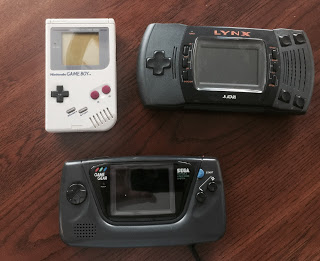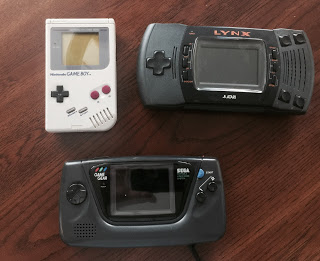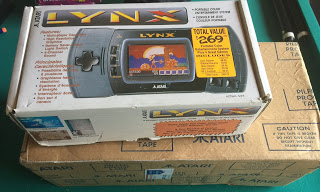Now for me the Lynx had, up until that point, always been a bit of a mystery. I knew Atari had briefly flirted with a handheld system around the time of the Nintendo Game Boy, and that it was notoriously hard on batteries, but that was all I knew. I’m probably not alone in having thought this or saying it now, but many of us in that time regarded Atari as being a bit behind the times, and not as serious into gaming as Nintendo or Sega. As a newly minted Nintendo fan, I thought my Game Boy was the best portable system you could get at the time, so in my fanboy-ism I dismissed the idea of a portable Atari. As it turns out though the Atari Lynx was probably the most advanced and forward thinking portable system at the time. In an era of poorly light monochromatic screens, the Atari Lynx, and its successor the Lynx II offered a backlit, full color and switchable screen, despite having only followed the original Nintendo Game Boy on to the market by two months, and full 17 months before the Sega Game Gear. The reality was that the Atari Lynx was the most advanced portable system on the market, however without the access to choice third party titles, or well known first party franchises like Nintendo with Tetris, and Super Mario Land respectively, the Lynx was forced into the background. Also much like I stated above, and like I mentioned about the Atari Jaguar in an earlier post, Atari had a stigma on it at the time that kept it’s products from being taken seriously by gamer’s. In July of 1991, two months after the release of Sega’s Game Gear, Atari would release the Lynx II, a lighter, and more battery friendly version of the original Lynx with many other improved features. Again though, consumers went more for the problematic Game Gear over the Lynx II, mainly for the Sega name, and access to portable versions of the Sega games including the Sonic franchise.
 |
| Rygar, trust me up close it looks great |
The Lynx would continue to be sold until 1995, but after the release of the Jaguar, Atari distanced itself more and more from it’s portable system. Much like other Atari systems, nostalgia and fanboy loyalty kept the system alive and it did see home brews and ports as early as the late-90’s. Today, Lynx and Atari die-hard’s keep the system alive, and it’s story is slowly but surely being told.
Getting to Know the Atari Lynx
As for my experiences, finding a deal on an Atari Lynx was the biggest thing to overcome. They can be found on eBay, but one in good condition with a few games and/or accessories can be a $150 proposition, and don’t even ask about original packaging. So I decided to take a look at Best Electronics instead since I had bought some Atari 7800, and Jaguar items there before. For $150 there I picked up a Lynx II in box, with 3 loose, and 2 NIB games as part of a package. Best Electronics, if you didn’t know, are Atari specialists and have access to a lot of Atari’s old stock, so I knew I was getting my Lynx from a trusted source. Shortly after that I set out on eBay, and was able to pick up a stack if CIB games for next to nothing, since oddly the system is hard to get but the games aren’t with the Lynx.
When my Lynx arrived in that wonderful Atari packaging, I opened it up and dropped in one of those unique bent credit card shaped games. Expecting that the above mentioned, Christian, might of over-hyped the Lynx, I quickly found out he was dead on. The image on the Lynx screen, was bright and crisp, and I can tell you its ruined me on non-backlit screens. Every game I put in is the same story, the colors are vibrant and clear, game play is fantastic, and sound is good. By far one of my favorites is Rygar an excellent port of the arcade game, and something I continually return to on the Lynx, although many of the other games I have such as Slime World, Klax, and Crystal Mines are also very good.
So now for the good and the bad. An unexpected bit of good news is that I am still on the same set of battery’s I put in in February, and there is no sign of them giving out. The bad news is, and this is a minor thing, is that the controls can be a bit laggy and/or stiff. That is more of an annoyance though, and I haven’t really found that it’s caused any issues in game play.
Recently on Google Plus, Old School Game Vault asked a question about how you would rank the old portable systems among the Lynx, Game Boy, and Game Gear. Owning all three now (and I will talk about the Game Gear in a later post), I had a hard time choosing a number one between the Lynx and Game Boy, and the Game Gear was my obvious number three. As a huge player and fan of the Game Boy, and with serious nostalgia for it I wanted to make it my number one but the Lynx was, and is the best system undoubtedly to come out of that era by just how far more advanced it was over it’s competitors. So the Lynx took my number one, with my beloved Game boy hot on its heals, and the Game Gear lagging far behind.
 |
| Size Comparison |
As I mentioned above Lynx’s aren’t the easy to find cheaply, but if you want a really cool handheld gaming experience the Lynx is a must. When you play it you will have to continually remind yourself that the Lynx was in fact, on the market the same time as the original Game boy and not after, based on just how more advanced it looks and feels.




Leave a Reply